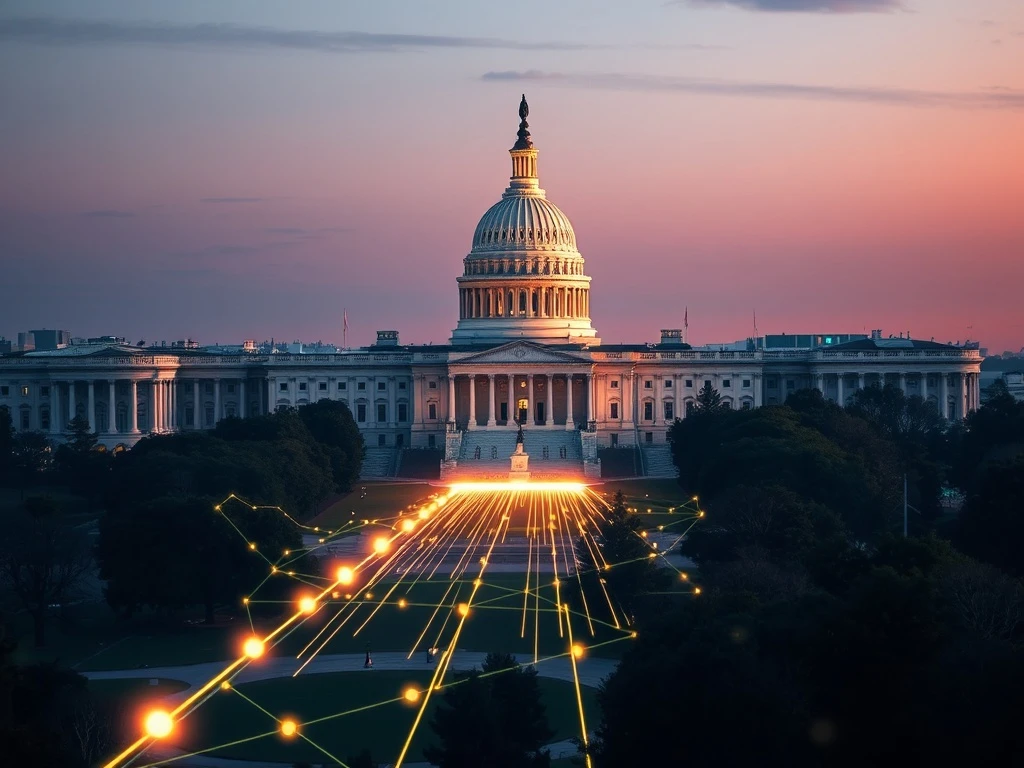Revolutionary US Blockchain Adoption: Economic Data to Go On-Chain

A groundbreaking announcement signals a new era for public data. The US Commerce Department will begin publishing key economic statistics, including gross domestic product (GDP) figures, directly on the blockchain. This move represents a significant leap in **US Blockchain Adoption**, promising enhanced transparency and data integrity for citizens and markets alike. Crypto enthusiasts are watching closely, as this decision validates the technology’s potential at the highest levels of government.
A Pivotal Shift for Economic Data On-Chain
US Commerce Secretary Howard Lutnick recently unveiled this ambitious plan. He spoke during a White House cabinet meeting on Tuesday. Lutnick confirmed the department will first publish **GDP Data Blockchain**, then gradually include other economic data. This initiative aims to expand blockchain-based data distribution across various government agencies. Secretary Lutnick directly addressed President Donald Trump. He highlighted Trump’s reported affinity for digital assets. “The Department of Commerce is going to start issuing its statistics on the blockchain,” Lutnick stated. “Because you are the crypto president, we are going to put our GDP on the blockchain so people can use it for data and distribution.”
This decision marks a strategic embrace of distributed ledger technology. The Commerce Department will manage the initial rollout. They will iron out all necessary details for implementation. This phased approach allows for careful integration and testing. It also sets a precedent for future **economic data on-chain** applications. The initiative could eventually extend across other federal departments. It signals a serious commitment to leveraging blockchain’s unique capabilities for public administration.
Why Government Blockchain Initiatives are Gaining Momentum
Governments worldwide increasingly explore blockchain technology. They seek solutions for secure data management and transparent public services. Several successful **Government Blockchain Initiatives** already exist globally. These examples demonstrate the technology’s practical benefits:
- Estonia: Since 2016, Estonia has used Guardtime’s KSI blockchain. It secures over a million patient records in its e-Health system. This infrastructure also supports parts of its digital ID network. Estonia stands as an early pioneer in government blockchain use.
- European Blockchain Services Infrastructure (EBSI): Launched in 2018, EBSI is a permissioned network. It runs on Hyperledger Besu. Member states like France, Slovenia, and Denmark host validator nodes. This decentralized structure delivers verifiable and trustworthy cross-border public services.
- Singapore and Australia: In 2021, these nations trialed a blockchain system. It issued and verified cross-border trade documents. This reduced paperwork and cut costs significantly.
- California DMV: The Department of Motor Vehicles digitized 42 million car titles in 2024. They used a permissioned Avalanche blockchain. This curbs lien fraud and streamlines vehicle transfers.
These diverse applications highlight blockchain’s versatility. It offers governments enhanced security, efficiency, and public trust. The **US Blockchain Adoption** for economic data aligns with this global trend. It shows a growing recognition of blockchain’s potential beyond cryptocurrencies.
Understanding GDP Data Blockchain and Its Implications
The decision to put **GDP Data Blockchain** raises important questions. Primarily, it addresses data integrity. Blockchain provides a tamper-proof recordkeeping system. Once data enters the chain, altering it becomes extremely difficult. This creates an immutable audit trail. Such transparency can build public trust in official statistics. However, it is crucial to understand blockchain’s limitations. The technology secures *how* data is stored and shared. It does not inherently address the *accuracy* of the initial data input. Human error or deliberate misinformation can still occur before data is recorded on-chain.
This distinction is particularly relevant given recent political discourse. Former President Trump has often questioned the reliability of US economic data. For instance, he downplayed a 0.3% first-quarter GDP contraction in April. He called it a “tariff-driven blip.” In May, he dismissed a Congressional Budget Office forecast of 1.8% growth. He predicted the economy could expand by 9%. On August 1, Trump fired Bureau of Labor Statistics Commissioner Erika McEntarfer. This followed a July jobs report showing only 73,000 new positions. He accused her of releasing “rigged” data. Economists expressed alarm at this action. Blockchain can ensure that once data is published, it remains unchanged. It cannot, however, validate the original figures supplied by reporting entities.
The Future of Digital Transformation Government
This move by the Commerce Department signals a broader shift. It represents a significant step towards **Digital Transformation Government**. The initiative begins with GDP data. It aims to gradually include other vital economic statistics. This could pave the way for other federal agencies. They might explore similar blockchain implementations. Imagine secure, verifiable data for:
- Census information
- Health records
- Supply chain logistics
- Voting systems
The potential for enhanced transparency and efficiency is vast. However, challenges remain. These include:
- Scalability: Handling large volumes of data requires robust infrastructure.
- Interoperability: Ensuring different blockchain systems can communicate is vital.
- Regulatory Frameworks: New policies are needed to govern blockchain data.
- Privacy Concerns: Balancing transparency with sensitive personal data protection.
Addressing these issues will be critical for widespread **US Blockchain Adoption**. This bold step, however, establishes a strong foundation. It demonstrates a commitment to innovation within public service.
The US Commerce Department’s decision marks a pivotal moment. It solidifies the role of blockchain technology in public administration. By putting **economic data on-chain**, the US aims for greater transparency and trust. This initiative positions the nation at the forefront of **Government Blockchain Initiatives**. It also drives forward the larger vision of **Digital Transformation Government**. While challenges exist, the potential benefits for data integrity and public confidence are immense. This development will undoubtedly inspire further exploration and adoption of blockchain across the federal landscape.







